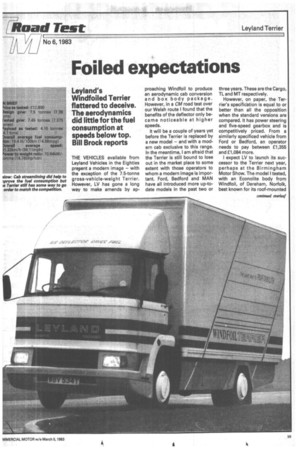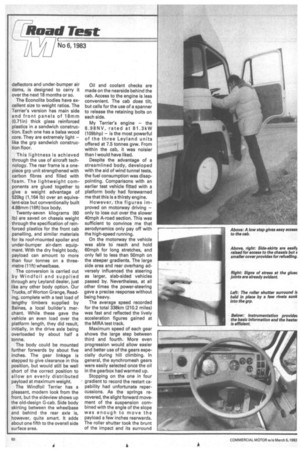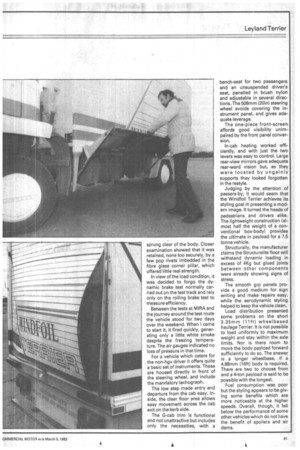Foiled expectations
Page 61

Page 62

Page 63

If you've noticed an error in this article please click here to report it so we can fix it.
Leyland's Windf oiled Terrier flattered to deceive. The aerodynamics did little for the fuel consumption at speeds below top. Bill Brock reports
THE VEHICLES available from Leyland Vehicles in the Eighties prepent a modern image — with the exception of the 7.5-tonne gross-vehicle-weight Terrier. However, LV has gone a long way to make amends by ap proaching Windfoil to produce an aerodynamic cab conversion and box body package. However, in a CM road test over our Welsh route I found that the benefits of the deflector only beca me noticeable at higher speeds.
It will be a couple of years yet before the Terrier is replaced by a new model — and with a modern cab exclusive to this range. In the meantime, I am afraid that the Terrier is still bound to lose out in the market place to some extent with those operators to whom a modern image is important. Ford, Bedford and MAN have all introduced more up-todate models in the past two or three years. These are the Cargo, TL and MT respectively.
However, on paper, the Terrier's specification is equal to or better than all the opposition when the standard versions are compared. It has power steering and five-speed gearbox and is competitively priced. From a similarly specificed vehicle from Ford or Bedford, an operator needs to pay between £1,355 and £1,084 more.
I expect LV to launch its successor to the Terrier next year, perhaps at the Birmingham Motor Show. The model I tested, with an Econolite body from Windfoil, of Dereham, Norfolk, best known for its roof-mounted deflectors and under-bumper air dams, is designed to carry it over the next 18 months or so.
The Econolite bodies have excellent size to weight ratios. The Terrier's version has main side and front panels of 1 8mm (0.71in) thick glass reinforced plastics in a sandwich construction. Each one has a balsa wood core. They are extremely light — like the grp sandwich construction floor.
This lightness is achieved through the use of aircraft technology. The rear frame is a onepiece grp unit strengthened with carbon fibres and filled with foam. The lightweight components are glued together to give a weight advantage of 520kg (1,164 lb) over an equivalent-size but conventionally built 4.88mm (16ft) box body.
Twenty-seven kilograms (60 lb) are saved on chassis weight through the specification of reinforced plastics for the front cab panelling, and similar materials for its roof-mounted spoiler and under-bumper air-dam equipment. With the dry freight body, payload can amount to more than four tonnes on a threemetre (11ft) wheelbase.
The conversion is carried out by Windfoil and supplied through any Leyland dealer, just like any other body option. Our Trucks, of Worton Grange, Reading, complete with a test load of lengthy timbers supplied by Baines, a local builder's merchant. While these gave the vehicle an even load over the platform length, they did result, initially, in the drive axle being overloaded by about half a tonne.
The body could be mounted further forwards by about five inches. The gear linkage is stepped to give clearance in this position, but would still be well short of the correct position to allow an evenly distributed payload at maximum weight.
The Windfoil Terrier has a pleasant, modern look from the front, but the sideview shows up the old-design G-cab. Side body skirting between the wheelbase and behind the rear axle is, however, quite smart. It adds about one fifth to the overall side surface area. Oil and coolant checks are made on the nearside behind the cab. Access to the engine is less convenient. The cab does tilt, but calls for the use of a spanner to release the retaining bolts on each side.
My Terrier's engine — the 6.9 8 NV, rated at 8 1.3 kW (109bhp) — is the most powerful of the three Leyland units offered at 7.5 tonnes gvw. From within the cab, it was noisier than I would have liked.
Despite the advantage of a streamlined body, developed with the aid of wind tunnel tests, the fuel consumption was disappointing. Comparisons with an earlier test vehicle fitted with a platform body had forewarned me that this is a thirsty engine.
However, the figures improved on motorway driving — only to lose out over the slower 40mph A-road section. This was sufficient to convince me that aerodynamics only pay off with the high-speed running.
On the motorway the vehicle was able to reach and hold 60mph for long stretches, and only fell to less than 50mph on the steeper gradients. The large side area and rear overhang adversely influenced the steering as larger, slab-sided vehicles passed by. Nevertheless, at all other times the power-steering gave a precise response without being heavy.
The average speed recorded for the total 338km (210.2 miles) was fast and reflected the lively acceleration figures gained at the MIRA test track.
Maximum speed of each gear shows the large step between third and fourth. More even progression would allow easier and better use of the gears especially during hill climbing. In general, the synchromesh gears were easily selected once the oil in the gearbox had warmed up.
Stopping on the one in four gradient to record the restart capability had unfortunate repercussions. As the springs recovered, the slight forward movement of the suspension combined with the angle of the slope was enough to move the payload a few inches rearwards. The roller shutter took the brunt of the impact and its surround sprung clear of the body. Closer examination showed that it was retained, none too securely, by a few pop rivets imbedded in the fibre glass corner pillar, which offered little real strength.
In view of the load condition, it was decided to forgo the dynamic brake test normally carried out on the test track and rely only on the rolling brake test to measure efficiency.
Between the tests at MIRA and the journey around the test route the vehicle stood for two days over the weekend. When I came to start it, it fired quickly, generating only a little white smoke despite the freezing temperature. The air gauges indicated no loss of pressure in that time.
For a vehicle which caters for the non-hgv driver it offers quite a basic set of instruments. These are housed directly in front of the steering wheel, and include the mandatory tachograph.
The low step made entry and departure from the cab easy. Inside, the clear floor area allows easy movement across the cab exit on the kerb side.
The G-cab trim is functional and not unattractive but includes only the necessities, with a bench-seat for two passengers and an unsuspended driver's seat, panelled in brush nylon and adjustable in several directions. The 508mm (20in) steering wheel avoids covering the instrument panel, and gives adequate leverage.
The one-piece front-screen affords good visibility unimpaired by the front panel conversion.
In-cab heating worked efficiently, and with just the two levers was easy to control. Large rear-view mirrors gave adequate rear-ward vision but, as they were located by ungainly supports they looked forgotten in the restyle.
Judging by the attention of passers-by, it would seem that the Windfoil Terrier achieves its styling goal in presenting a modern image. It turned the heads of pedestrians and drivers alike. The lightweight construction (almost half the weight of a conventional box-body) provides the ultimate in payload for a 7.5 tonne vehicle.
Structurally, the manufacturer claims the Structurelite floor will withstand dynamic loading in excess of 4Kg but glued joints between other components were already showing signs of stress.
The smooth grp panels pro vide a good medium for sign writing and make repairs easy, while the aerodynamic styling helped to keep the vehicle clean. Load distribution presented some problems on the short 3.35mm (1 ift) wheelbased haulage Terrier. It is not possible to load uniformly to maximum weight and stay within the axle limits. Nor is there room to move the body payload forward sufficiently to do so. The answer is a longer wheelbase, if a 4.88mm (16ft) body is required. There are two to choose from and a 4-ton payload is said to be possible with the longest.
Fuel consumption was poor but the styling appears to be giv ing some benefits which are more noticeable at the higher speeds. Overall, though, it fell below the performance of some other vehicles which do not have the benefit of spoilers and air dams.












































































































